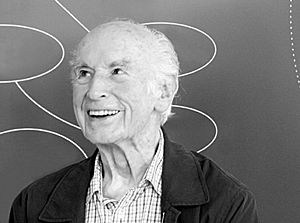Albert Hofmann facts for kids
Quick facts for kids
Albert Hofmann
|
|
|---|---|

Hofmann in 1993
|
|
| Born | 11 January 1906 |
| Died | 29 April 2008 (aged 102) Burg im Leimental, Basel-Landschaft, Switzerland
|
| Alma mater | University of Zürich (PhD) |
| Occupation |
|
| Employer | Sandoz |
| Spouse(s) | Anita Hofmann (died 2007) |
| Children | 4 |
| Relatives | Gustav Guanella (brother-in-law) |
| Awards | Scheele Award |
Albert Hofmann (11 January 1906 – 29 April 2008) was a Swiss chemist . He authored more than 100 scientific articles and numerous books. In 2007, he shared first place with Tim Berners-Lee on a list of the 100 greatest living geniuses published by The Daily Telegraph newspaper.
Contents
Early life and education
Albert Hofmann was born in Baden, Switzerland, on 11 January 1906. He was the first of four children to factory toolmaker Adolf Hofmann and Elisabeth (née Schenk) and was baptized Protestant. When his father became ill, Hofmann obtained a position as a commercial apprentice in concurrence with his studies. At age 20, Hofmann began his chemistry degree at the University of Zürich, finishing three years later, in 1929. Owing to his father's low income, Albert's godfather paid for his education. Hofmann's main interest was the chemistry of plants and animals, and he later conducted important research on the chemical structure of the common animal substance chitin, for which he received his doctorate with distinction in 1929.
Career
Of his decision to pursue a career as a chemist, Hofmann provided insight during a speech he delivered to the 1996 Worlds of Consciousness Conference in Heidelberg, Germany:
One often asks oneself what roles planning and chance play in the realization of the most important events in our lives. [...] This [career] decision was not easy for me. I had already taken a Latin matricular exam, and therefore a career in the humanities stood out most prominently in the foreground. Moreover, an artistic career was tempting. In the end, however, it was a problem of theoretical knowledge which induced me to study chemistry, which was a great surprise to all who knew me. Mystical experiences in childhood, in which Nature was altered in magical ways, had provoked questions concerning the essence of the external, material world, and chemistry was the scientific field which might afford insights into this.
Further research
Hofmann became director of Sandoz's natural products department and continued studying substances found in Mexican mushrooms and other plants used by aboriginal people there.
In 1963, Hofmann attended the annual convention of the World Academy of Arts and Sciences (WAAS) in Stockholm.
Later years
Hofmann was a longtime friend and correspondent of German author and entomologist Ernst Jünger, whom he met in 1949.
Archives
After retiring from Sandoz in 1971, Hofmann was allowed to take his papers and research home. He gave his archive to the Albert Hofmann Foundation, a Los Angeles-based nonprofit, but the documents mostly sat in storage for years. The archives were sent to the San Francisco area in 2002 to be digitized, but that process was never completed. In 2013, the archive was sent to the Institute of Medical History in Bern, Switzerland, where it is being organized.
Death
Hofmann died at the age of 102 from a heart attack, on 29 April, 2008, in Switzerland.
Honors and awards
The Swiss Federal Institute of Technology (ETH Zurich) honored him with the title DSc (honoris causa) in 1969 together with Gustav Guanella, his brother-in-law. In 1971 the Swedish Pharmaceutical Association granted him the Scheele Award, which commemorates the skills and achievements of the Swedish Pomerania chemist and pharmacist Carl Wilhelm Scheele.
See also
 In Spanish: Albert Hofmann para niños
In Spanish: Albert Hofmann para niños
- James Fadiman
- David E. Nichols
- Alexander Shulgin
- Owsley Stanley


